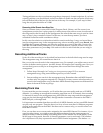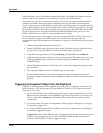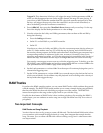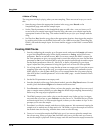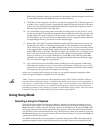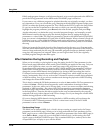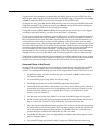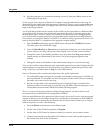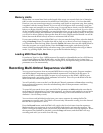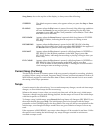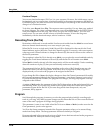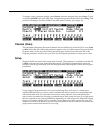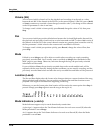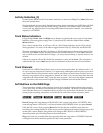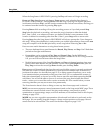
Song Mode
Recording Multi-timbral Sequences via MIDI
12-23
Memory Limits
While there’s no actual time limit to the length of the songs you record, their size is limited to
64K (or to the maximum amount of available free RAM space you have, if it’s less than 64K).
However, you can create longer songs by recording each section as a separate song, then putting
it together with the Arrange feature. If you run out of RAM space while recording a song, the
recorder stops and prompts you to save the song. It’s a good idea to check your free RAM space
before you begin recording a song, and to check the “Used” field as you record. If you’ve used
all the available RAM for recording, you may find that when you go to the Song Editor to delete
a song or edit its tempo, the K2661 tells you that there’s not enough memory to edit. In this case
you won’t be able to edit any object greater than 4K in size. Objects smaller than 4K can still be
edited, because the K2661 always reserves a minimum of 4K of RAM.
If you want to delete a song and the K2661 won’t let you enter the Song Editor, select the default
song (1 NewSong). Since it’s smaller than 4K (as long as you haven’t saved any changes to it),
you’ll be able to enter the Song Editor. Press the Delete soft button, then use the Alpha Wheel to
select the program you want to delete. Press the Delete button again, and the song will be
erased, freeing up enough RAM to edit other songs. (You could also delete the song in Master
mode—by pressing Object, then Delete, to get to the file deletion dialog.)
Loading MIDI Files From Disk
If you have a Type 0 or Type 1 MIDI sequence file stored on a SmartMedia card or a SCSI device,
you can load it into one of the RAM banks, and the K2661 will be able to play it from Song
mode. If the MIDI file has the GM On Sysex message in it, the imported song will have the GM
parameter set to On automatically.
Recording Multi-timbral Sequences via MIDI
You can record sequences from an external MIDI device using Song mode. Program numbers
and MIDI channel assignments of multi-timbral sequences are recorded with the notes. To
record via MIDI, connect the MIDI Out port of your sequencer to the K2661’s MIDI In port.
Select Song mode, and set the Clock parameter to External. This will sync the K2661 with the
MIDI clock of the external sequencer.
You will probably want to set the Local Keyboard Channel parameter to None when recording
from an external sequencer, since the rechannelizing effect of that parameter could have
unintended results.
To record all your tracks in one pass, set the RecTrk parameter to Mult and make sure that for
each channel of information on your source sequence, you have a track enabled to record and a
unique channel assigned to that track. (The default setting of all tracks enabled to record on
channels 1–16 will always work.)
You can also record individual tracks from your source sequence by setting the RecTrk
parameter to a specific track. The K2661 will record only information coming in on the channel
that the RecTrk parameter is set to.
Press the Record button, and the K2661 will wait for the first clock start from the sequencer.
Make sure that your sequencer is set to send MIDI clock signals, and start the sequence. The
K2661 will begin recording when it receives the first MIDI clock start from the sequencer. When
the sequencer has finished its playback, press the Stop soft button, and the K2661 will stop
recording and ask if you want to save the song.



